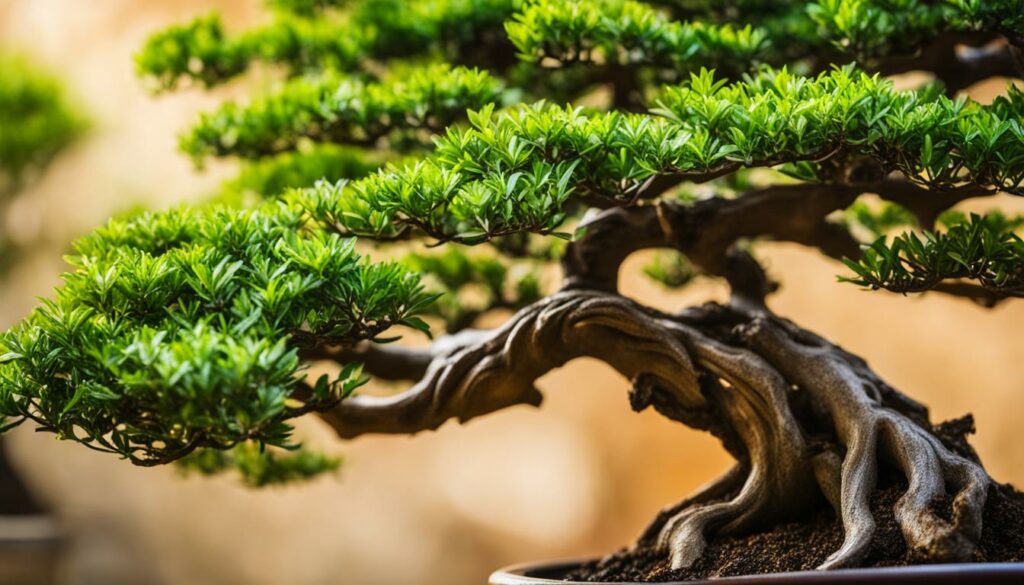If you’re a bonsai enthusiast, you’re probably familiar with various bonsai species ranging from pine and elm to maple and juniper. But have you considered adding the Bonsai Tree Species Myrtle to your collection? Also known as Myrtus bonsai, this aromatic evergreen plant has become increasingly popular among horticulturists and gardeners alike.
In this section, we will explore the charm and characteristics of the Bonsai Tree Species Myrtle and how it can add an aromatic touch to your bonsai collection. From its origins to proper care and training techniques, we will cover all aspects of this elegant tree.
Key Takeaways
- The Bonsai Tree Species Myrtle is an aromatic evergreen plant and a popular choice among bonsai enthusiasts.
- Myrtle bonsai originates from the Mediterranean region and can thrive in various environments.
- Correct watering, pruning, and shaping techniques are crucial for maintaining the health and vitality of Myrtle bonsai.
- Potted Myrtle bonsai adds a unique aesthetic appeal and can be styled in different ways to enhance the beauty of your tree.
- Myrtle bonsai has cultural and historical significance and is believed to bring positive energy to its surroundings.
Introduction to Myrtle Bonsai
Explore the beauty and charm of Myrtle bonsai, a delightful evergreen species that thrives in various environments thanks to its Mediterranean origins.
Myrtle bonsai is a popular choice among bonsai enthusiasts worldwide, valued for its hardy nature, colorful blooms, and aromatic foliage. Whether adding an elegant touch to your indoor space or outdoor garden, Myrtle bonsai is a versatile and rewarding tree species to care for.
Notably, Myrtle bonsai is evergreen, retaining its foliage throughout the year, making it ideal for any season. In addition, its signature scent adds an aromatic touch to your home or garden, making it a favorite among those who appreciate fragrant plants.
Discover more about Myrtle bonsai, its origins, and the unique characteristics that make it a beloved species among bonsai enthusiasts worldwide.
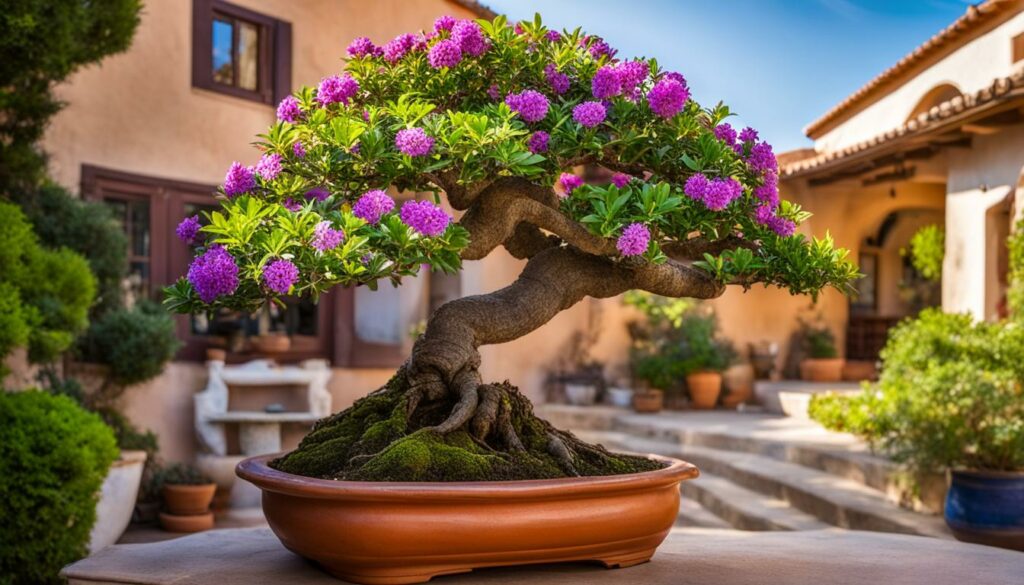
Myrtle Bonsai Care Guide
Proper care and maintenance are essential for the longevity and health of your Myrtle bonsai tree. Follow these tips to ensure that your bonsai thrives:
Watering Your Myrtle Bonsai
Water your Myrtle bonsai regularly to keep the soil moist but not waterlogged. You can determine whether your bonsai tree needs watering by checking the soil’s moisture level. Poke your finger about an inch into the soil; if the soil feels dry, it’s time to water. Use lukewarm water and avoid using chlorinated water, as Myrtle bonsai trees are sensitive to chlorine.
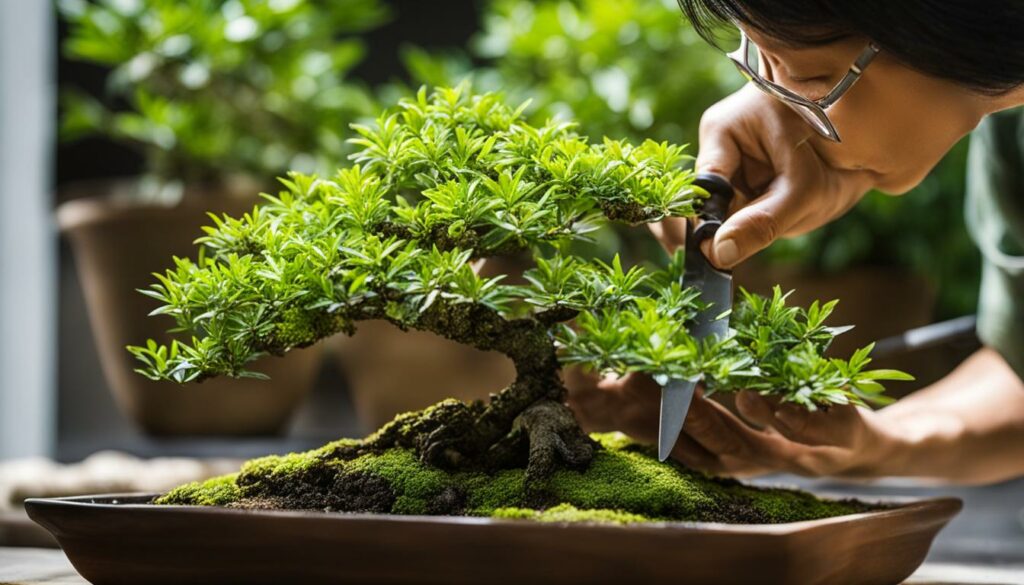
Pruning and Shaping Your Myrtle Bonsai
Pruning is essential for maintaining the shape of your Myrtle bonsai tree. Use clean and sharp pruning shears to cut away any dead or diseased branches. Shaping your bonsai tree is done by wiring the branches into the desired position. Be cautious when wiring; avoid damaging the bark or bending the branches at sharp angles as it may cause permanent damage to your bonsai tree.
Providing Ideal Growing Conditions for Myrtle Bonsai
Myrtle bonsai trees are evergreen and thrive in full sun or partial shade. They can tolerate cold temperatures but not sudden changes or extreme weather conditions. Provide your bonsai tree with sufficient light and humidity, along with good air circulation. Fertilize your bonsai tree during its growing season using a balanced fertilizer to ensure it gets the nutrients it needs.
Diagnosing and Treating Myrtle Bonsai Diseases and Pests
Keep an eye out for common diseases and pests that may affect Myrtle bonsai trees, such as spider mites, scale insects, and root rot. Treat these problems quickly using appropriate insecticides and fungicides. Regularly inspect your bonsai tree for signs of these issues by checking the leaves and branches for abnormalities or discoloration.
Potted Myrtle Bonsai: Aesthetic Appeal
Bringing the beauty and charm of Myrtle bonsai trees into your home is a wonderful way to add a touch of elegance and nature to your décor. One way to showcase their appeal is by potting them in an aesthetically pleasing way. There are various potting styles and techniques to consider when displaying your potted Myrtle bonsai.
If you’re looking for a natural, rustic look, consider placing your Myrtle bonsai in a natural terracotta pot. These types of pots not only complement the tree’s Mediterranean heritage but also provide good drainage. Alternatively, for a modern appeal, you may wish to choose a stylish ceramic pot in various colors or patterns. Remember to choose a pot that is the appropriate size and shape for your tree, as this will help keep your tree healthy and well-anchored.
When potting your Myrtle bonsai, ensure the soil is nutrient-rich and well-draining. An equal mixture of regular potting soil, coarse sand, and perlite is ideal for bonsai potting. Try to avoid using regular garden soil, as it can cause drainage problems, resulting in root rot and other issues.
With proper consideration and attention to detail, your potted Myrtle bonsai tree can become a standout feature in any indoor or outdoor space.
Myrtle Bonsai Training Techniques
Training a Myrtle bonsai tree is an art that requires patience and precision. By employing several techniques such as wiring, pruning, and shaping, you can mold and create a unique bonsai that reflects your personality and style. Here are some essential tips for training your Myrtle bonsai:
Wiring
Wiring is a technique used to guide the growth of the branches and trunk of Myrtle bonsai. Copper or aluminum wire is wrapped around the branches, and they are gently bent into the desired shape. The wire should be applied loosely enough to avoid damaging the tree but tight enough to be effective. It is essential to remove the wire before it cuts into the bark, as this could damage the plant. Ensure that the wire does not dig into the bark by checking and adjusting it regularly.
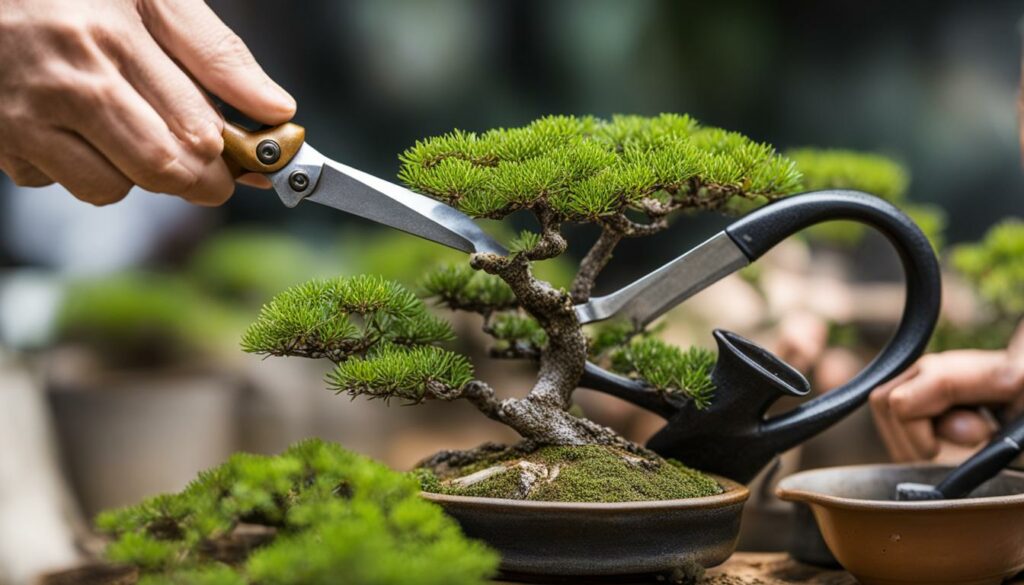
Pruning
Pruning is a fundamental technique in bonsai art, and it’s essential for the long-term health of your Myrtle bonsai. This technique involves removing unwanted branches and leaves, promoting new growth, and encouraging the development of your desired shape. It is essential to use sharp tools to avoid damaging the tree and to prune only at the appropriate time of year, usually during dormancy.
Shaping
Shaping involves careful and precise cutting of the branches and leaves to achieve the desired design, size, and shape. It is often combined with wiring to produce beautiful, natural curves and lines that make up the bonsai’s form. Ensure that your tree receives proper nutrition and sunlight to avoid poor growth and to facilitate faster healing, which is necessary for shaping techniques.
“Training a bonsai tree is a way of expressing your creativity and personality, and with Myrtle bonsai, the possibilities are endless.”
Myrtle Bonsai Design Ideas
You can unleash your creative flair and explore various design ideas to enhance the aesthetic appeal of your Myrtle bonsai tree. Here are some design ideas to inspire you:
Formal Upright Style
The formal upright style is a popular design idea for Myrtle bonsai. With a straight and symmetrical trunk, this style is achieved by pruning and wiring the branches, leaving enough space between them to create a layered effect. This design idea highlights the beautiful foliage of the Myrtle bonsai and is perfect for creating a centerpiece in your garden.
Cascade Style
The cascade style is a captivating design idea for Myrtle bonsai, perfect for showcasing the cascading foliage and unique features of the tree. Achieving this style requires wiring the branches downwards and allowing them to cascade over the edge of the pot, creating a captivating effect. This design idea works well in a hanging pot and is perfect for adding a touch of sophistication to your garden.
Slanting Style
The slanting style is a bold and dramatic design idea for Myrtle bonsai. With a leaning trunk, this design creates an illusion of wind-swept trees and is achieved by wiring the trunk to a slanting angle. This design idea is perfect for creating a dynamic and powerful statement in your bonsai collection and will capture the attention of anyone who views it.
Experimenting with various design ideas for your Myrtle bonsai tree allows you to add your own unique stamp on your bonsai collection. Be creative and let your imagination soar to create an unforgettable Myrtle bonsai tree.
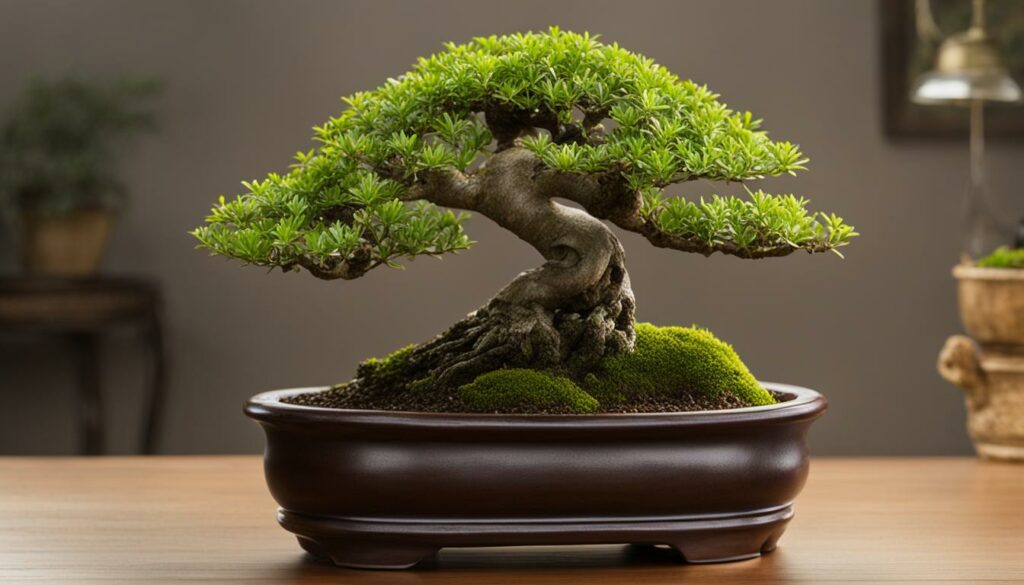
Myrtle Bonsai: Symbolism and Meaning
The Myrtle bonsai holds special symbolism and meaning in various cultures across the globe. In ancient Greek mythology, the Myrtle tree was dedicated to Aphrodite, the goddess of love, fertility, and beauty. It was believed to symbolize love, prosperity, and happiness.
Similarly, in Jewish culture, the Myrtle tree is one of the four species used during the celebration of the festival of Sukkot. It represents joy and has a unique fragrance that is said to embody the essence of the Garden of Eden.
Additionally, the Myrtle bonsai is highly regarded in Feng Shui, a Chinese philosophical system that emphasizes harmonizing energy forces to promote good health and fortune. The Myrtle tree is believed to bring positive energy and promote prosperity, growth, and overall well-being.
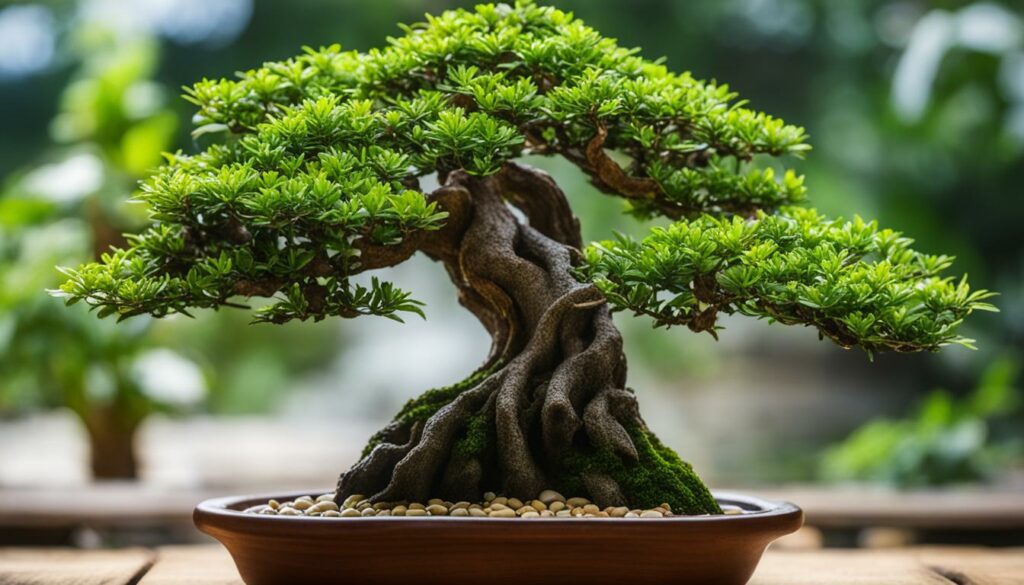
Overall, the Myrtle bonsai holds significant cultural and historical importance, with its symbolism and meaning reflecting love, prosperity, joy, and positive energy. Incorporating a Myrtle bonsai into your indoor or outdoor space can not only add to the aesthetics but also bring positive energy and good vibes into your home or office.
Common Diseases and Pests of Myrtle Bonsai
As much as we want our Myrtle bonsai to remain healthy and robust, they can fall prey to various diseases and pests. Here are some of the common ones to watch out for:
| Disease/Pest | Symptoms | Treatment |
|---|---|---|
| Black Spot | Black spots on leaves, leaf drop, stem canker | Remove infected leaves and stems, apply fungicides if necessary |
| Root Rot | Yellowing leaves, stunted growth, wilting | Cease watering, inspect roots for damage, replace soil if necessary |
| Scale Insects | Sticky residue on leaves and branches, yellowing foliage, misshapen stems | Remove with a soft brush or cotton swab, apply insecticides if necessary |
Prevention is key to maintaining the health of your Myrtle bonsai. Ensure proper watering, fertilization, and environmental conditions. Regularly inspect your tree for any signs of diseases or pests. Timely intervention can help prevent further damage and ensure the longevity of your bonsai tree.
By following the proper care techniques and understanding the potential threats, you can ensure your Myrtle bonsai will thrive for years to come.
Conclusion
Now that you’ve learned all about Myrtle bonsai, you can appreciate its unique charm and beauty. This evergreen Mediterranean bonsai is a popular choice among bonsai enthusiasts because of its aromatic nature and ability to thrive in various environments. By following the proper care and maintenance tips, you can ensure the vitality and health of your Myrtle bonsai tree.
Be sure to explore different potting styles and techniques to showcase the aesthetic appeal of your potted Myrtle bonsai. Employ training techniques such as wiring and pruning to shape and style your bonsai according to your preferences.
Don’t forget to get creative with design ideas, whether you prefer a formal upright or cascading style. Whether you choose Myrtle bonsai for its symbolism and meaning or simply for its beauty, it is sure to enliven any space. Remember to identify and address common diseases and pests to ensure the longevity of your bonsai tree.
In conclusion, the Bonsai Tree Species Myrtle is a versatile, aromatic, and beautiful addition to any bonsai collection. With proper care and attention, it is sure to bring joy and tranquility to your home or garden.
FAQ
What is Myrtus bonsai?
Myrtus bonsai, also known as the Bonsai Tree Species Myrtle, is a charming and aromatic bonsai tree that belongs to the Myrtus genus. It is a species of evergreen bonsai native to the Mediterranean region.
Why is Myrtle bonsai popular among bonsai enthusiasts?
Myrtle bonsai is popular among bonsai enthusiasts due to its evergreen nature and its ability to thrive in various environments. It adds an aromatic touch to any bonsai collection and can be easily shaped and trained.
How do I care for Myrtus bonsai?
To care for Myrtus bonsai, you should ensure that it receives proper watering, pruning, and shaping. It prefers a sunny location and well-drained soil. Regular fertilizing and protection from extreme temperatures are also essential for its health and vitality.
What are the potting considerations for Myrtle bonsai?
When potting Myrtle bonsai, it is important to consider the size, style, and material of the pot. Additionally, proper root pruning and repotting techniques should be followed to ensure the aesthetic appeal and overall health of the bonsai tree.
What training techniques can be used for Myrtus bonsai?
Myrtle bonsai can be trained using various techniques such as wiring, pruning, and regular shaping. These techniques help in achieving the desired style and form of the bonsai tree. Patience and regular maintenance are crucial for successful training.
What are some design ideas for Myrtle bonsai?
There are several design ideas for Myrtle bonsai, including formal upright, cascade, slanting, and forest styles. Each style has its own unique aesthetic appeal and can enhance the overall beauty of your Myrtle bonsai tree.
What is the symbolism and meaning associated with Myrtle bonsai?
Myrtle bonsai holds historical and cultural significance, symbolizing love, peace, and prosperity. It is believed to bring positive energy and good fortune to its surroundings. Additionally, Myrtle is associated with the goddess of love and beauty in Greek mythology.
What are common diseases and pests that can affect Myrtle bonsai?
Myrtle bonsai can be susceptible to diseases such as powdery mildew and root rot, as well as pests such as scale insects and aphids. Regular inspection, proper hygiene, and timely treatment can help prevent and address these issues.
